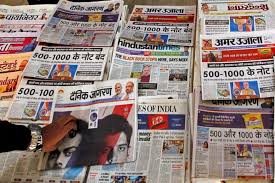Journalism is a complex phenomenon and Indian media is in a shaky space.
A lot of journalism today is quite horrible. It is shrill, it is intolerant, it is partisan. The media, in India at least, is not talking about issues that mean something. Not only is the epicentre of the coverage the political elite (here also, coverage is not distributed uniformly across the political spectrum) but the reporter is also going missing. Just a glance over the prime-time debates of different news channels shows how a lot of the focus is on the celebrity anchor. Information is disseminated not through reportage but through ‘debates’ that are seldom more than bickering.
Print media and the growing digital space still seem to be better placed, but even here we have shortcomings. There is a wide range of issues of growing contemporary relevance that does not get adequate attention. Not a lot of the media is talking about questions of privacy, big data, or climate change. The Guardian recently decided to cover climate change stories by using terms such as “crisis”, “emergency” and “catastrophe” instead of “climate change”. These stories, however, do not get adequate space in many parts of the Indian media.
We do not cover international stories adequately either. There is just one news channel, WION, that keeps international news as its prime focus. Even when newspapers do publish stories in their ‘world’ or ‘international’ sections, those are usually excerpts of stories from other international media – New York Times and the like – or taken from wire services like Reuters or AP. There is not a lot of original reporting that the Indian media is doing. When we do, it mostly relates to Pakistan, and even that is not of excellent quality. The repercussions of this are not simply that the Indian populace has lesser access to original world affairs coverage done by Indian media – indeed, it restricts access to global news for many, period – but also that it leaves a void of Indian perspective in global affairs. The world’s biggest democracy and one of the largest economies of the world, housing the enormous diversity that it does, needs to have its authentic voice in the world. And the media has a key role in creating that voice.
Rural affairs and agriculture, which still directly or indirectly relate to a majority of Indians, are covered in passing glances. Although, the situation seems slightly better here. However, perhaps the way these beats are covered is inadequate. In his landmark book, Everybody Loves a Good Drought, P. Sainath details how the media approaches rural affairs – the displacement of tribal populations because of the construction of a dam, high levels of malnutrition among rural children, alcoholism – by viewing them as events, rather than examining the longstanding processes behind them.
Education-related news does not makeit to mainstream media, as often as it should. For an electorate to be mature, it needs to be aware of what is being taught in its schools and colleges. The recent Syllabus Controversy of the University of Delhi should have ideally been a matter of national discussion, for the questions it posed about academic autonomy and the like.
Of course, not everything is bad; bad journalism is simply a lot noisier and more visible. But even fundamentally, journalism and the media are in a fix.
What about objectivity? Do journalists need to hide all their personal biases and provide information, or is there virtue in consciously taking the side of the ‘voiceless’? Should media houses have a professed ideology – even if they cover stories objectively – or should they be largely neutral, with editorial positions varying as per specific issues?
Even after all this, what about the business side of things? For all the perceived glamour of the 9 p.m. star anchors, media is not as lucrative as it seems. Newspapers and channels don’t often even make profits, while large staff layoffs are not very rare either. Newspapers are having to grapple with questions of subscriptions and paywalls, a transition from print to digital, and new models of revenue generation – with varying degrees of success. In the face of all this, Indian media needs to step up its game.
Feature Image Credits: Financial Express
Prateek Pankaj



 1) The Satanic Verses
1) The Satanic Verses
 5) The Polyester Prince
5) The Polyester Prince